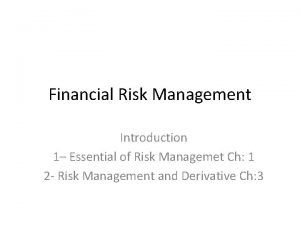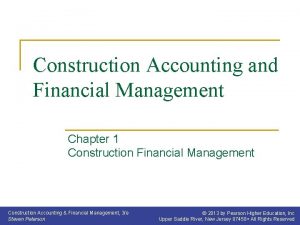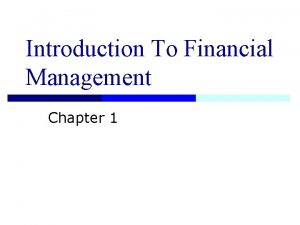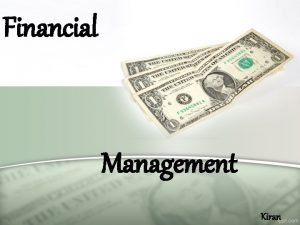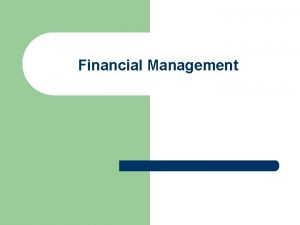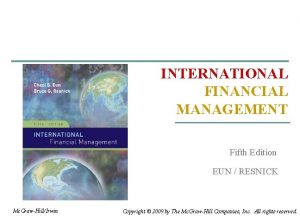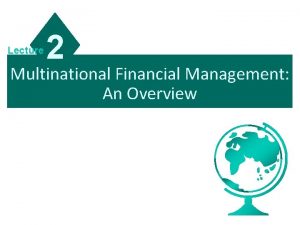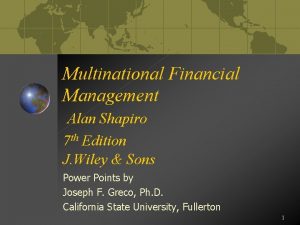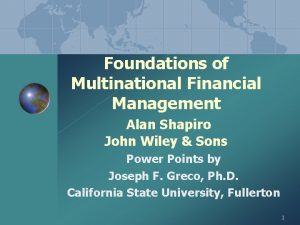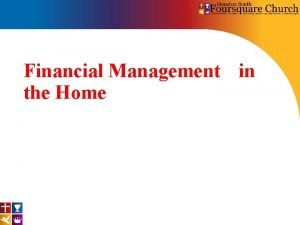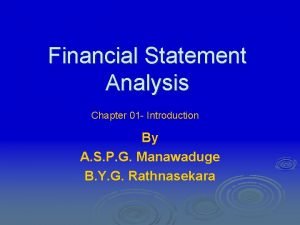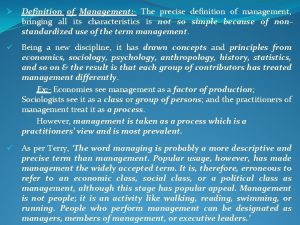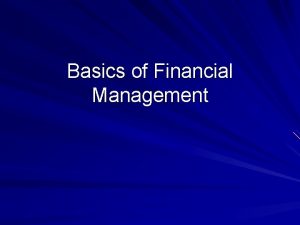Introduction to Financial Management 1 Financial Management Definition













- Slides: 13

Introduction to Financial Management 1

Financial Management Definition. Financial management deals with how companies ranging from small start-ups to major corporations effectively manage their operating and fixed assets and fund them with an optimal mixture of temporary and permanent debt and equity financing. 2

Topics in Financial Management q Goals of the firm q Corporate governance and executive compensation q Financial statement analysis q Financial statement quality q Maturity matching q Financial planning and growth q Capital budgeting q Risk and return q Cost of capital q Working capital management q q q q q Temporary financing Permanent financing Capital structure Business valuation Mergers and acquisitions and corporate restructuring Bankruptcy, liquidation, reorganizations Dividend policy Risk management International financial management 3

Organizational Fit 4

Professional Designations q Chartered Professional Accountant (CPA) q Chartered Financial Analyst (CFA) q Chartered Business Valuator (CBV) q Chartered Insolvency and Restructuring Professional (CIRP) q Certified Financial Planner (CFP) q Certified Treasury Professional (CTP) 5

Goals of the Firm q Goal of the firm is to maximize the value of its common shares q Common share prices are calculated as the present value of expected future cash flows and the discount rate used reflects the project’s risk q Why not profit maximization? q Profit is an accounting figure that can be more easily manipulated than cash flows q Profit is for the current period only encouraging more short-term decision making q Profit does not incorporate risk prompting more risk taking 6

Share Price Maximization Company A Company B Company C Case 1 Cash flows or dividends per share Cost of capital Share value RRR CAD 6 6% 6% 6% CAD 100 6 ÷ 100 = 6% CAD 6 CAD 5 CAD 10 6% 6% 6% CAD 100 CAD 83 CAD 167 Case 2 Revised cash flows or dividends per share Cost of capital Revised share value RRR 6 ÷ 100 = 6% 5 ÷ 83 = 6% 10 ÷ 167 = 6% Case 3 Cash flows or dividends per share Revised cost of capital Revised share value Revised RRR CAD 6 6% 10% 5% CAD 100 CAD 60 CAD 120 6 ÷ 100 = 6% 6 ÷ 60 = 10% 6 ÷ 120 = 5% 7

Agency Costs q Management and ownership are separate, so they do not work in the shareholders’ best interest and maximize share price Why do agency costs occur? q q q q Managers are more worried about their job security than pursuing riskier, more profitable projects especially if they are near retirement Managers are focused on their pay and perks instead of their performance Executive pay is closely linked to a company’s size, growth, and media profile not profitability Boards of directors are not independent of the CEO and have conflicts of interest Boards of directors lack the time and expertise to perform their duties Auditors are not independent of management Shareholders of widely-held companies do not act to reduce agency costs Takeover defences prevent poor managers from being removed Actions q q q Improved corporate governance policies and practices Greater emphasis on “pay for performance” which links executive pay to achieving specific corporate goals thus increasing the firm’s share price Enhanced financial reporting and better auditor training and independence Rising activism by large institutional investors to address agency problems More corporate take-overs by competitors and private equity firms to remove poor performing managers Severance and change-of-control entitlements so poor performing managers do not resist take-overs 8

Corporate Governance, Executive Compensation, and Financial Reporting Canadian Securities Administrators (CSA) q q q NI 58 -101 Disclosure of Corporate Governance Practises NP 58 -201 Corporate Governance Guidelines NI 51 -102 Continuous Disclosure Obligations NI 51 -108 Auditor Oversight NI 52 -109 Certification of Disclosure in Issuers’ Annual and Interim Filings NI 52 -110 Audit Committees Accounting and Auditing Standards q International Financial Reporting Standards (IFRS) q International Standards Auditing (ISA) Canadian Coalition for Good Governance (CCGG) q Building High Performance Boards q Executive Compensation Principles q Director Compensation Policy System for Electronic Data Analysis and Retrieval (SEDAR) System for Electronic Disclosures by Insiders (SEDI) Canadian Public Accountability Board (CPAB) 9

Corporate Governance NI 58 -201 Corporate Governance Guidelines 1. 2. 3. 4. 5. 6. 7. 8. 9. 10. 11. Majority independent directors who meet regularly without dependent directors or management Independent director serves as board chair or appointed as lead director if that is not possible Board mandate defined in writing Written job descriptions for chairperson, CEO, and board committees Director orientation and continuing education Adopt code of business conduct and ethics Nominating, compensation, audit committees are composed of independent directors Audit committee members must possess good financial skills Optimum board size should be considered Regular evaluations of overall board, each committee, and each board member Formally determine the competencies and skills required by directors and incorporate these in the hiring process with a consideration of whether the candidate has enough time 10

Executive Compensation CCGG Executive Compensation Principles Principle 1 – A significant component of executive compensation should be “at risk” and based on performance. Principle 2 – Performance should be based on key business metrics that are aligned with corporate strategy and the period during which risks are assumed. Principle 3 – Executives should build equity in the company to align their interests with those of shareholders. Principle 4 – A company may choose to offer pensions, benefits, and severance and change-ofcontrol entitlements. When such perquisites are offered, the company should ensure that the benefit entitlements are not excessive. Principle 5 – Compensation structure should be simple and easily understood by management, the board, and shareholders. Principle 6 – Boards and shareholders should actively engage with each other and consider each other’s perspective on executive compensation matters. 11

Director Compensation CCGG Director Compensation Policy Principle 1 – Independence and Alignment with Shareholders Principle 2 – Reflect Expertise and Time Commitment Principle 3 – Compensation May Vary for Different Directors Principle 4 – Shareholding by Directors Principle 5 – Minimize Complexity and Ensure Transparency 12

Financial Reporting NI 51 -102 Continuous Disclosure Obligations Annual financial statements Interim reports MD&A Financial outlook Non-GAAP disclosures Annual information form Management information circular Notices of shareholder meetings and voting results q Proxy solicitation q Prospectus q q q q q Business acquisition report Take-over bid circular Changes in ownership Material change report Change of auditor Change of corporate structure Insider trading reports Restricted security disclosure News releases 13
 Essential of financial risk management
Essential of financial risk management Construction accounting and financial management
Construction accounting and financial management Introduction to financial management
Introduction to financial management Strategic financial management outlook is in nature
Strategic financial management outlook is in nature What is finance
What is finance Financial management meaning
Financial management meaning Modern approach in financial management
Modern approach in financial management International financial management 5th edition
International financial management 5th edition Multinational financial management definition
Multinational financial management definition Multinational financial management definition
Multinational financial management definition Multinational financial management shapiro
Multinational financial management shapiro Financial methods of motivation
Financial methods of motivation Introduction about financial problem
Introduction about financial problem Introduction of financial statement analysis
Introduction of financial statement analysis
